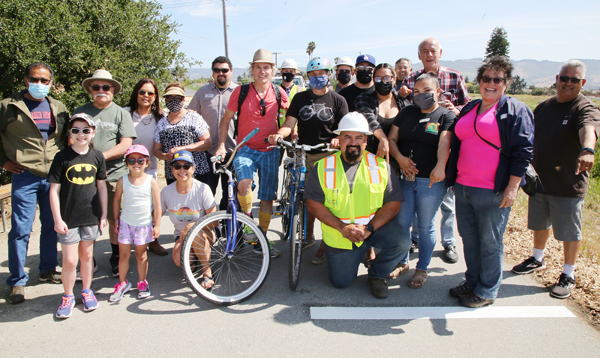WATSONVILLE—A locally brewed project of painting mile markers along the Pajaro River and Salsipuedes Creek levee system came to fruition Wednesday.
Buoyed by a large pack of community members, Watsonville City Councilmember Ari Parker, Santa Cruz County Supervisor Greg Caput, city and county workers and others celebrated the installment of the first white strip marker and the first bright red quarter-mile square scribed on the asphalt trail.
The project is the brainchild of Martha Vega, of Watsonville Community Development, who said her days often begin on the levee trail, like her mother.
“This project was made possible by so many city and county divisions and a lot of people that came up with this wonderful idea,” Vega said. “I have walked this so many times with my mother and she would ask, ‘How long have we walked?,’ and I always said that I had no idea. Or if there is a fire or other emergency—having these markers will help to identify a point of reference to 911 dispatchers. I am so grateful.”
Caput added: “The county got this done along with the support of the city of Watsonville and I just want to thank everyone who helped make this happen.”
Gina Cole of Bike Santa Cruz County (BSCC) showed up at the celebration on her bike.
“I encourage you all to tell a friend about this and come out and enjoy these great trails,” she said.
Cole added that on Saturday BSCC will host the Pride Ride starting at the first-mile marker across Bridge Street from the Watsonville Buddhist Temple at 11am.
Enrique Vasquez, Public Works operations manager for the city of Watsonville, said the marks will span 2.25 miles in both directions of the trail between Blackburn and Bridge streets to where it ends at East Lake Avenue and College Road.
“This means a lot to this community,” he said. “Ramon [Gomez] has played a big role in making this happen.”
Parker said she has family members that live nearby and that it is important to them to know how far they walk.
“This encourages more people to get out here and be healthy and to be able to recognize how far they are going,” Parker said. “And it certainly helps our emergency crews.”









